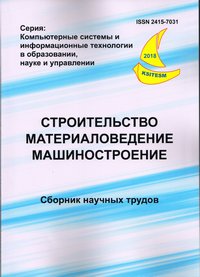Selection of сategorical parameters in modeling systems
DOI:
https://doi.org/10.30838/P.CMM.2415.270818.145.245Keywords:
system modeling, category parameters, factor levels, multiple regression model, optimization, non-linear programmingAbstract
The goal is to develop a methodology for working with factors that have several categorical levels to select one of the levels as a parameter of the simulated system. The technique. To select a parameter, statistical data are used, obtained either as a result of observations or as a result of a reusable simulation model run and, therefore, methods of mathematical statistics are used to achieve the goal. A multiple regression model is considered for categorical factors, the levels of which are presented as dummy variables. Results. The application of the proposed method allows not only to assess the effect of the factors and carry out a pair-wise comparative analysis of their levels, but also to determine one level of each categorical factor that is the best under these conditions. Scientific novelty. The proposed method makes it possible to reduce the problem of choosing a category parameter of the system being modeled to a regression analysis problem with subsequent testing for optimality of the regression function. The final choice of the parameter as one of the category levels in the case of two factors is found as a solution to the problem of nonlinear programming. Practical significance. The choice of parameters in the preparation of the system model is one of the main stages. There is no particular problem when it comes to parameters that take numerical values: for this purpose, the methods of mathematical statistics for testing hypotheses of expectation and two-sample criteria are used. In the case when the factor has several categorical (non-numeric) levels, dispersive analysis is used to analyze their influence, which makes it impossible to solve the problem with parameter selection. The proposed method allows you to make such a choice.References
Vasilev A.N. Nauchnyie vyichisleniya v Microsoft Excel [Scientific calculations in Microsoft Excel]. Moscow: Izdatelskiy dom «Vilyams», 2004, 512 p. (in Russian).
Dubrov A.M., Mhitaryan V.S. and Troshin L.I. Mnogomernyye statisticheskiye metody [Multicomponent statistical methods]. Moscow: Finansy i statistika, 2000, 352 p. (in Russian).
Kuzin L.T. Osnovy kibernetiki. Osnovy kiberneticheskikh modeley [Bases of cybernetics and Fundamentals of cybernetic of models]. Moscow: Energiya, 1979, 584 p. (in Russian).
Levin D.M., Devid Stefan, Timoti S. Krebil and Mark L. Berenson Statistika dlya menedzherov s ispolzovaniyem Microsoft Excel [Statistics is for managers from using Microsoft Excel]. Moscow: Izdatelskiy dom «Vilyams», 2004, 1312 p. (in Russian).
Takha H. A. Vvedenie v issledovaniye operatsiy [Introduction is to the analysis of operations]. Moscow: Izdatelskiy dom «Vilyams», 2007, 912 p. (in Russian).
Tomashevskiy V.M. Modelyuvannia system [Design of the systems]. Kyiv BHV: Vidavnicha grupa, 2005, 352 p. (in Ukrainian).
Tsibriy L.V. Vvedeniye v statisticheskiy analiz (uchebnoe posobie dlya vuzov) [Introduction to the statistical analysis]. Dnepropetrovsk: PGASA, 2016, 188p. (in Russian).
Downloads
Published
Issue
Section
License
Редакція Видання категорично засуджує прояви плагіату в статтях та вживає всіх можливих заходів для його недопущення. Плагіат розглядається як форма порушення авторських прав і наукової етики.
При виявлені у статті більш ніж 25% запозиченого тексту без відповідних посилань та використання лапок, стаття кваліфікується як така, що містить плагіат. У цьому випадку стаття більше не розглядається редакцією, а автор отримує перше попередження.
Автори, в статтях яких повторно виявлено плагіат, не зможуть публікуватися в усіх журналах Видавництва ДВНЗ «Придніпровська державна академія будівництва та архітектури».
Автори, які публікуються у цьому журналі, погоджуються з наступними умовами:
- Автори залишають за собою право на авторство своєї роботи та передають журналу право першої публікації цієї роботи на умовах ліцензії Creative Commons Attribution License, котра дозволяє іншим особам вільно розповсюджувати опубліковану роботу з обов'язковим посиланням на авторів оригінальної роботи та першу публікацію роботи у цьому журналі.
- Автори мають право укладати самостійні додаткові угоди щодо неексклюзивного розповсюдження роботи у тому вигляді, в якому вона була опублікована цим журналом (наприклад, розміщувати роботу в електронному сховищі установи або публікувати у складі монографії), за умови збереження посилання на першу публікацію роботи у цьому журналі.
- Політика журналу дозволяє і заохочує розміщення авторами в мережі Інтернет (наприклад, у сховищах установ або на особистих веб-сайтах) рукопису роботи, як до подання цього рукопису до редакції, так і під час його редакційного опрацювання, оскільки це сприяє виникненню продуктивної наукової дискусії та позитивно позначається на оперативності та динаміці цитування опублікованої роботи (див. The Effect of Open Access).

